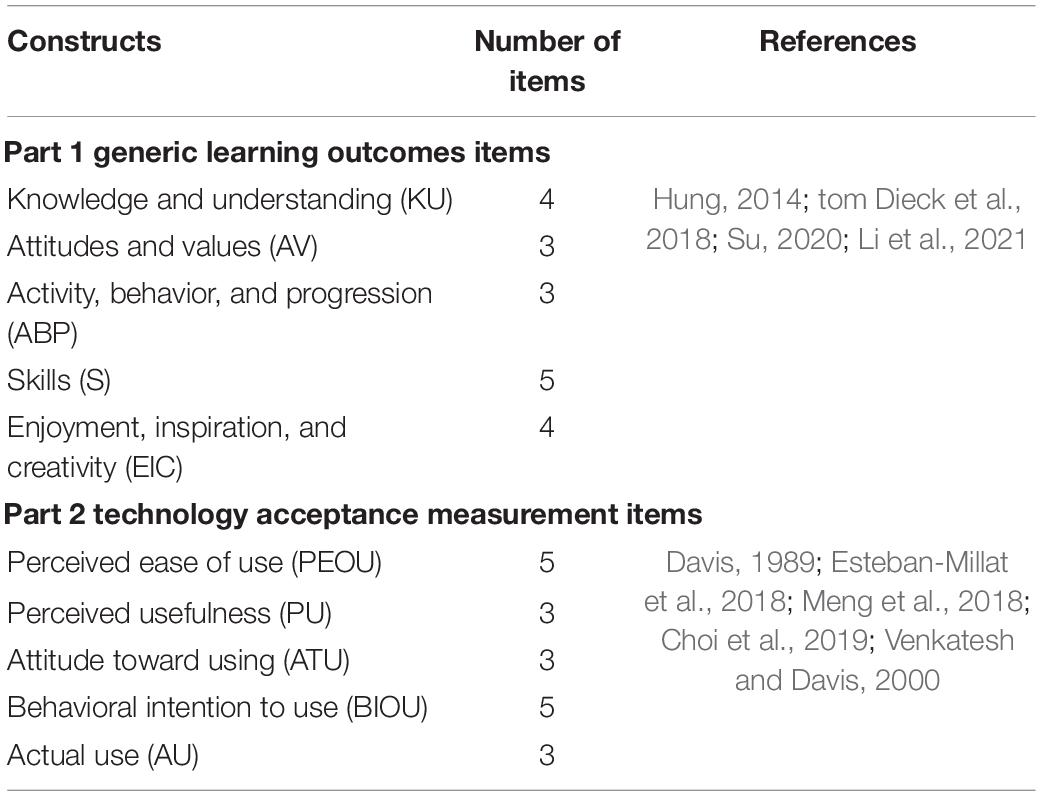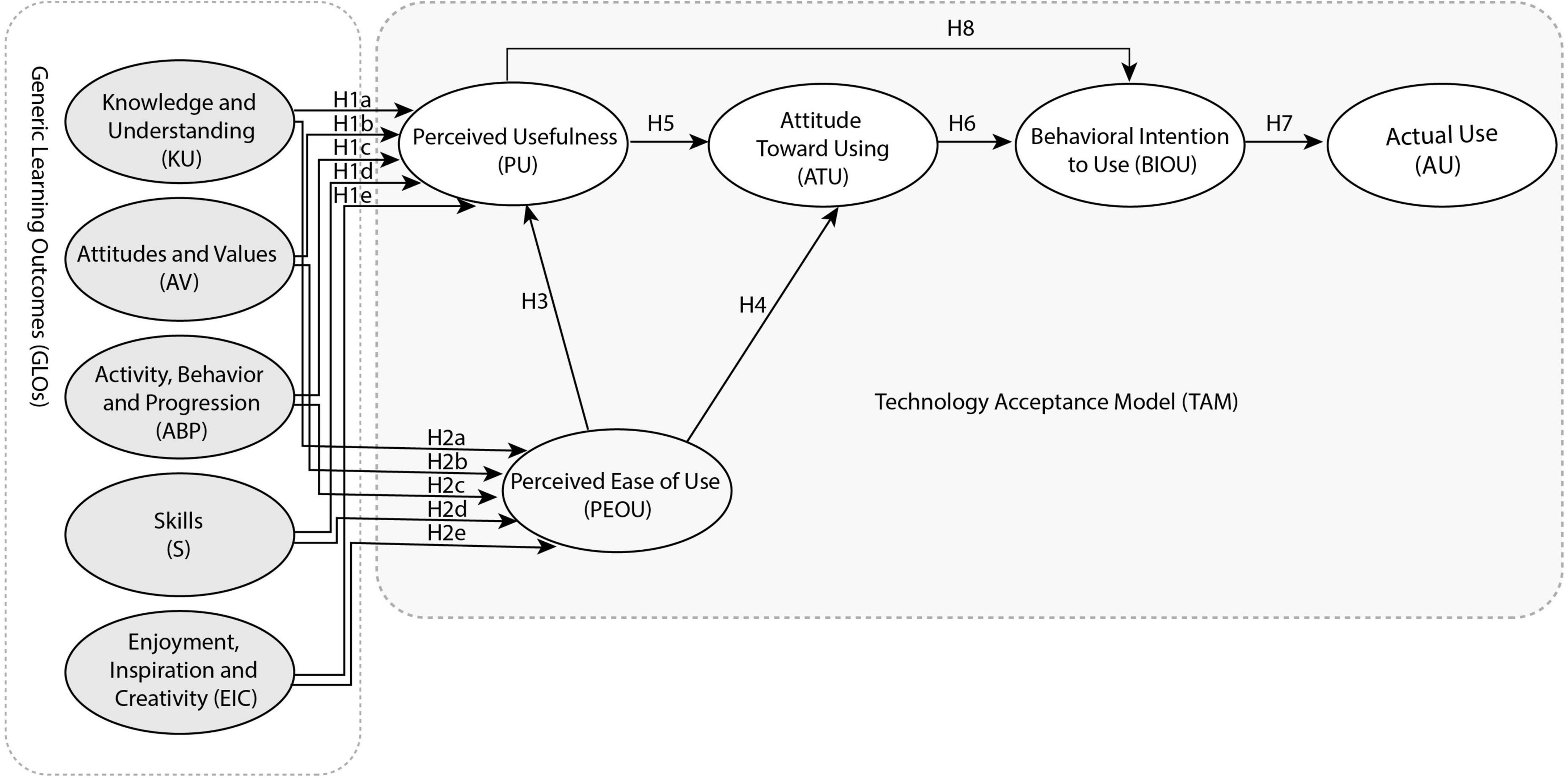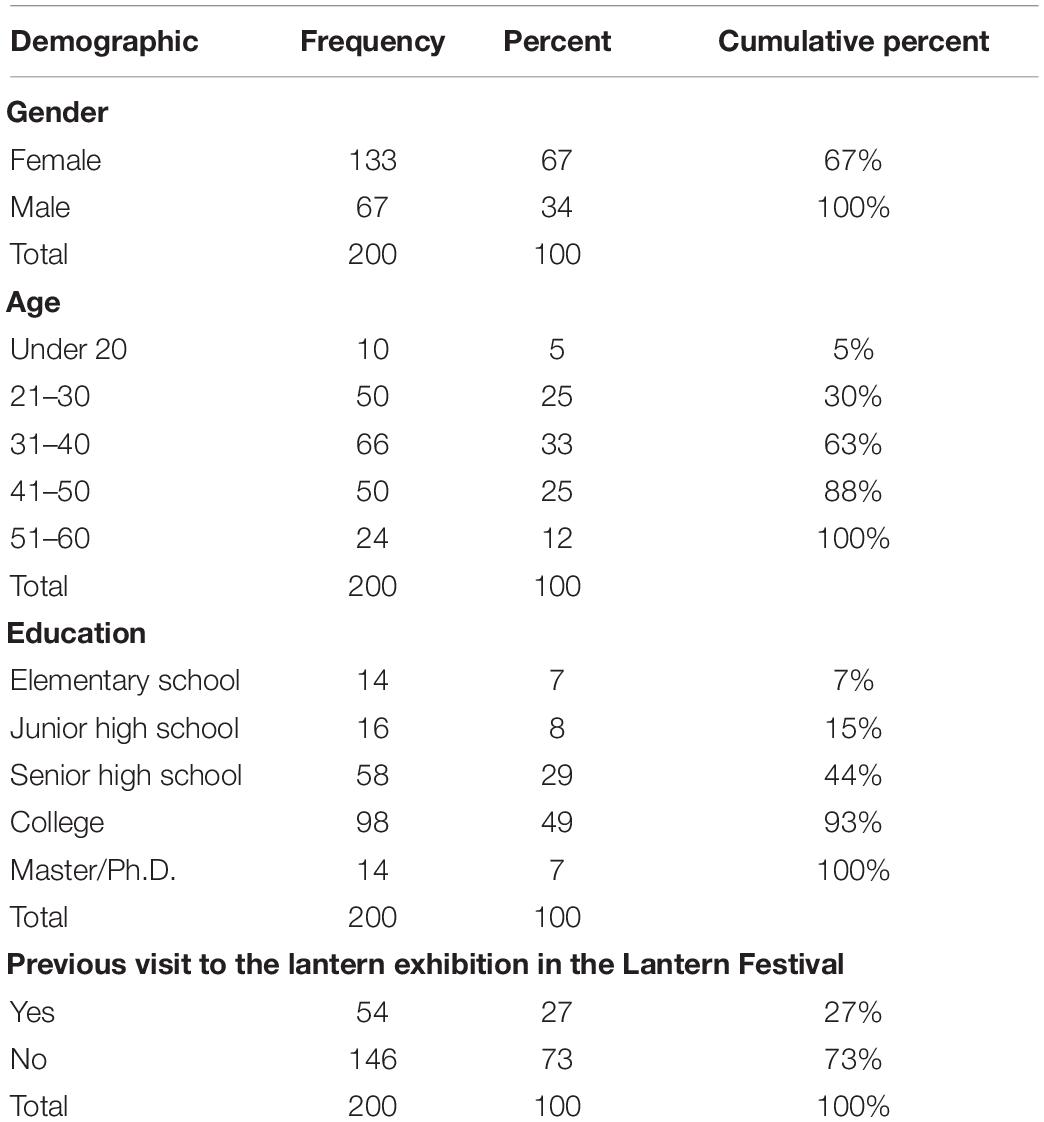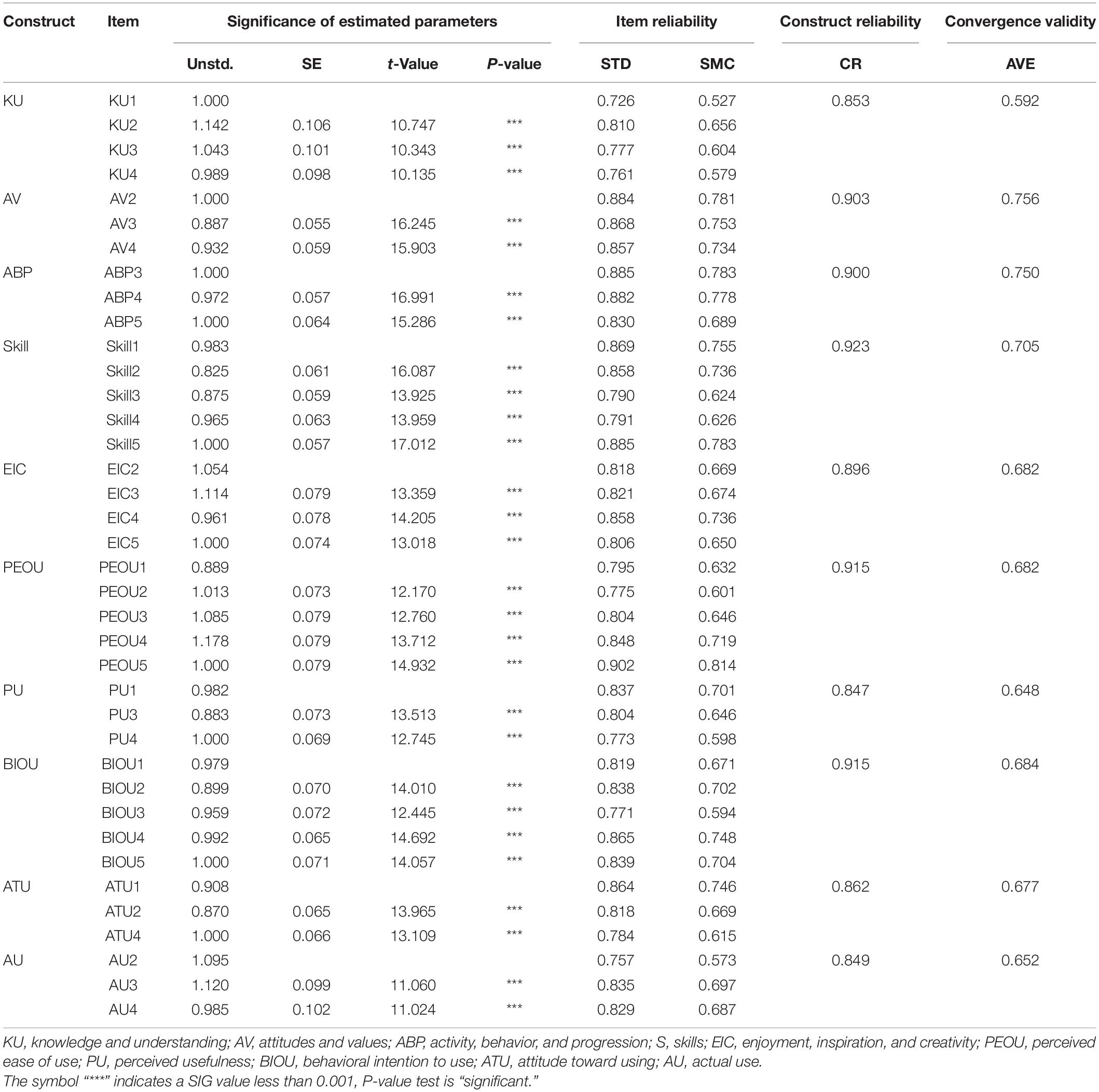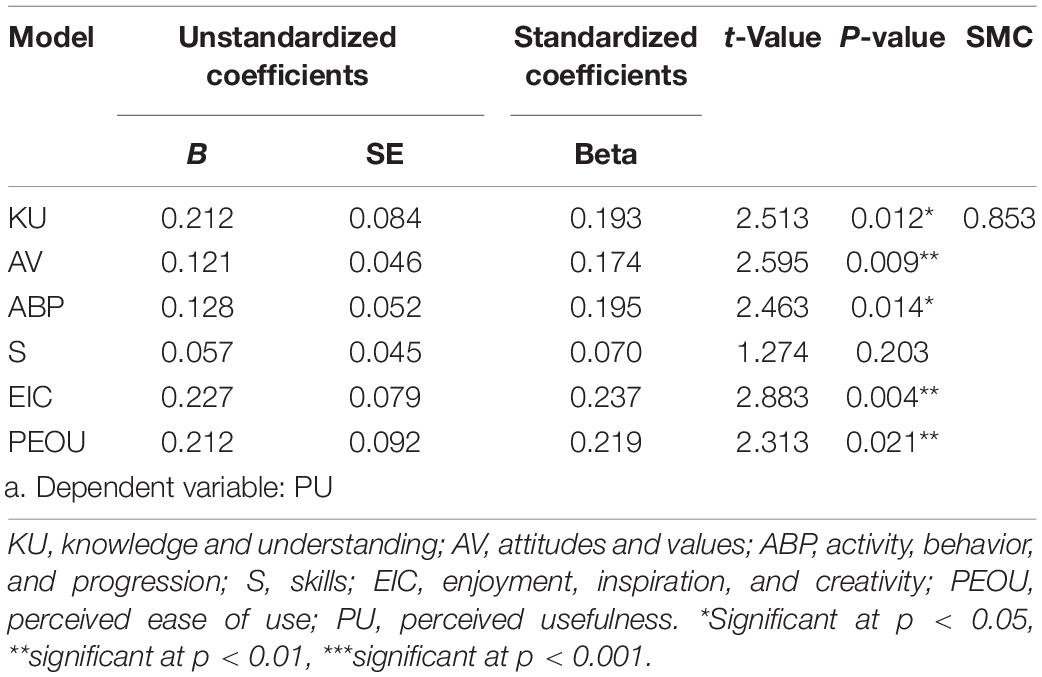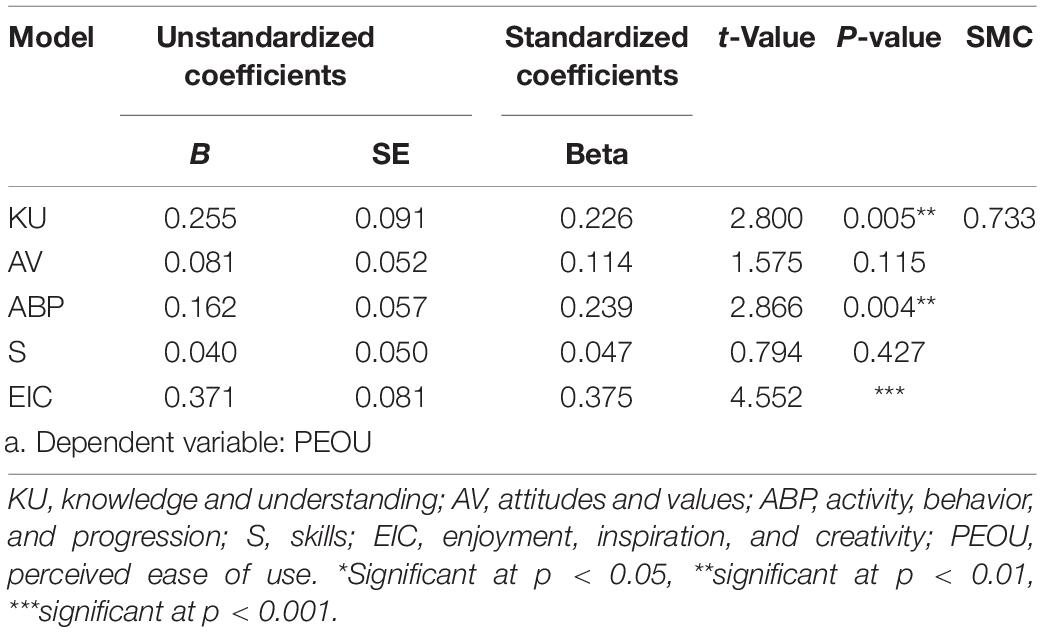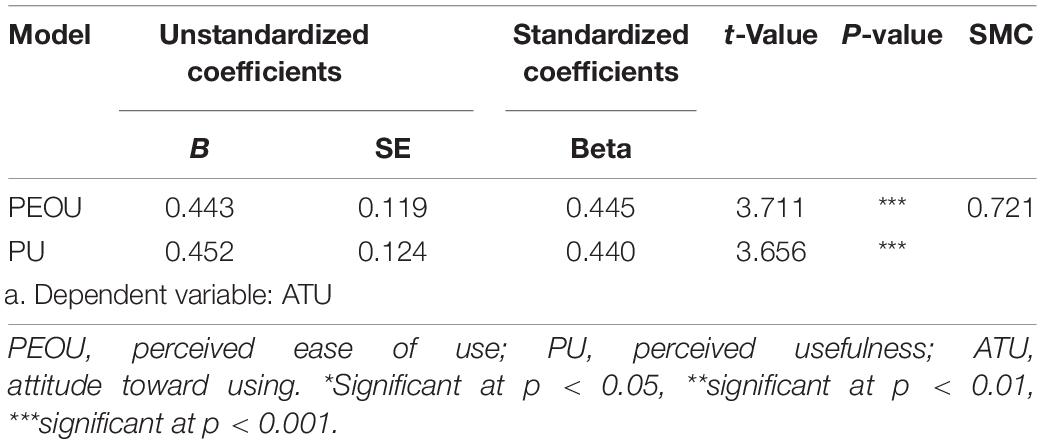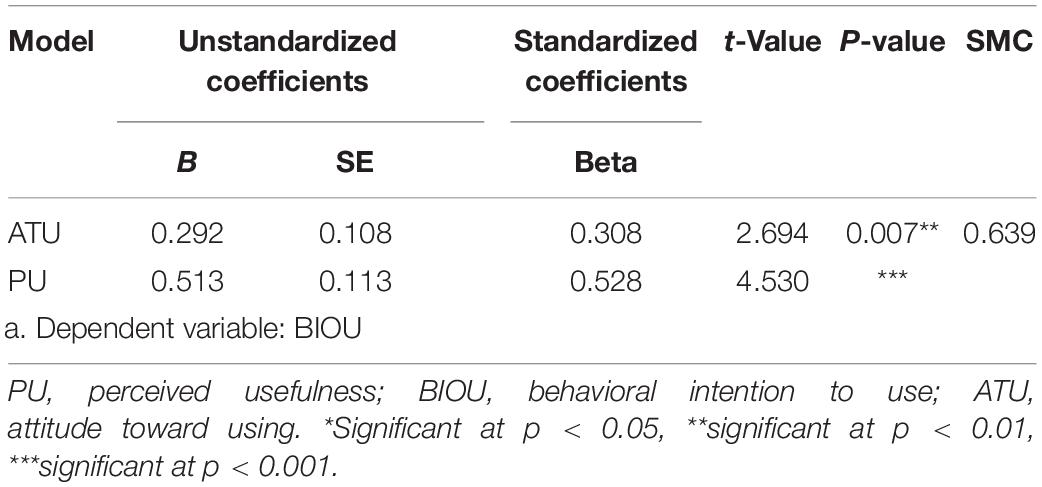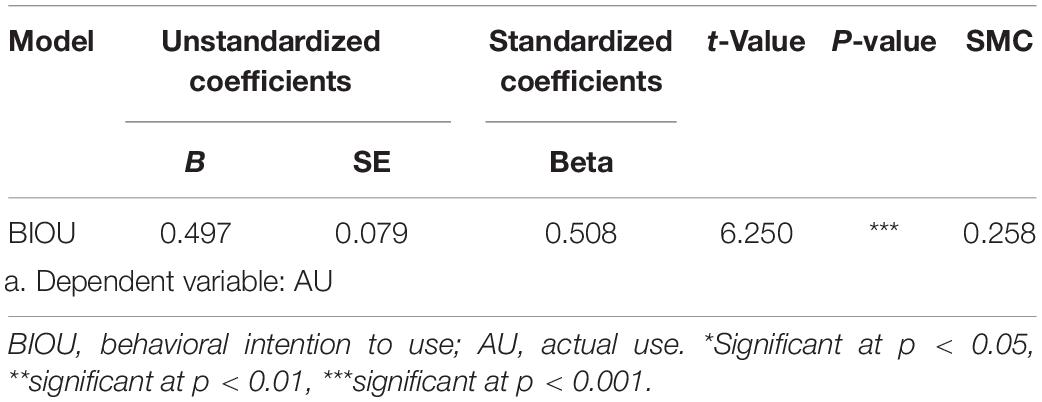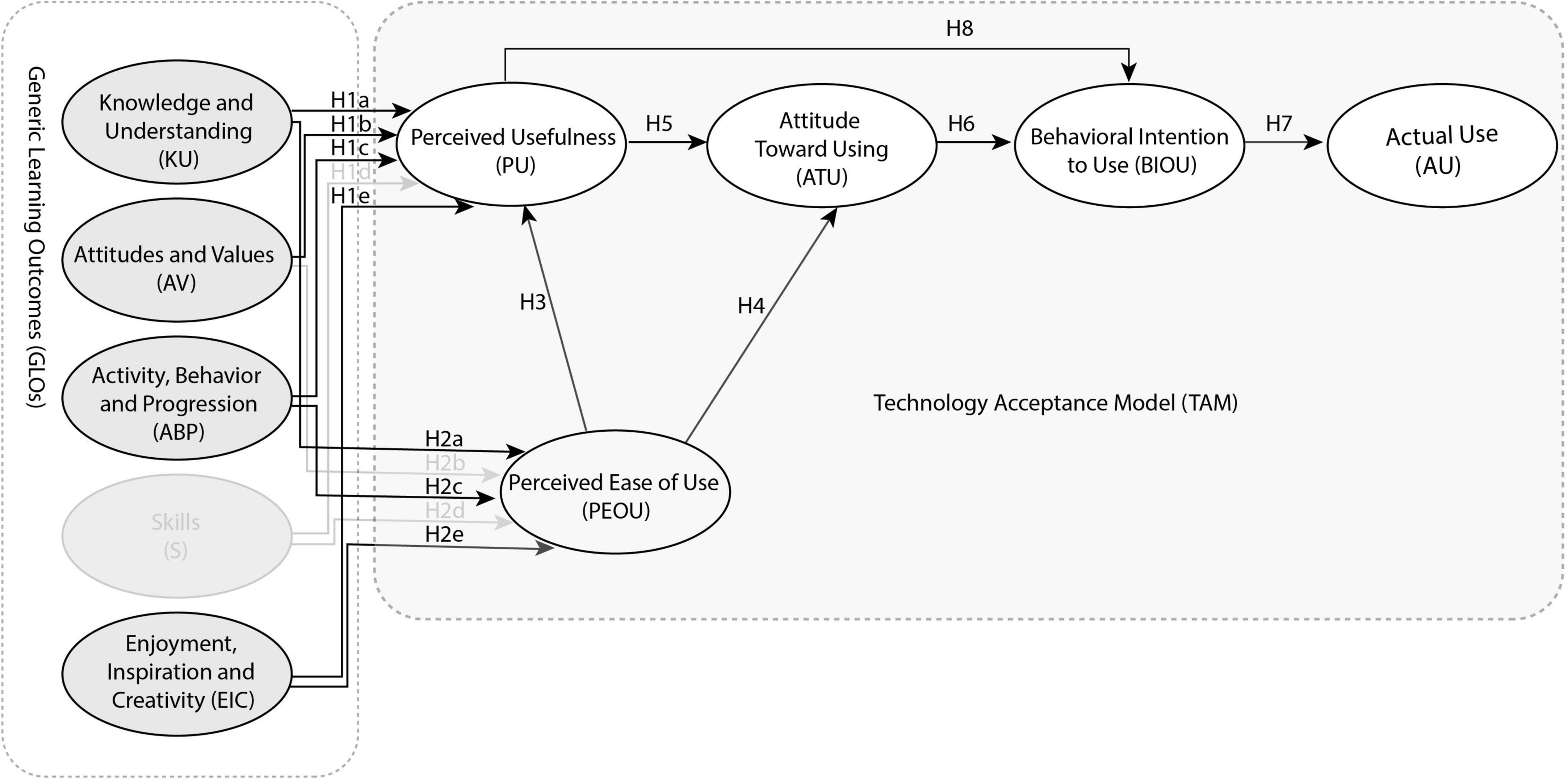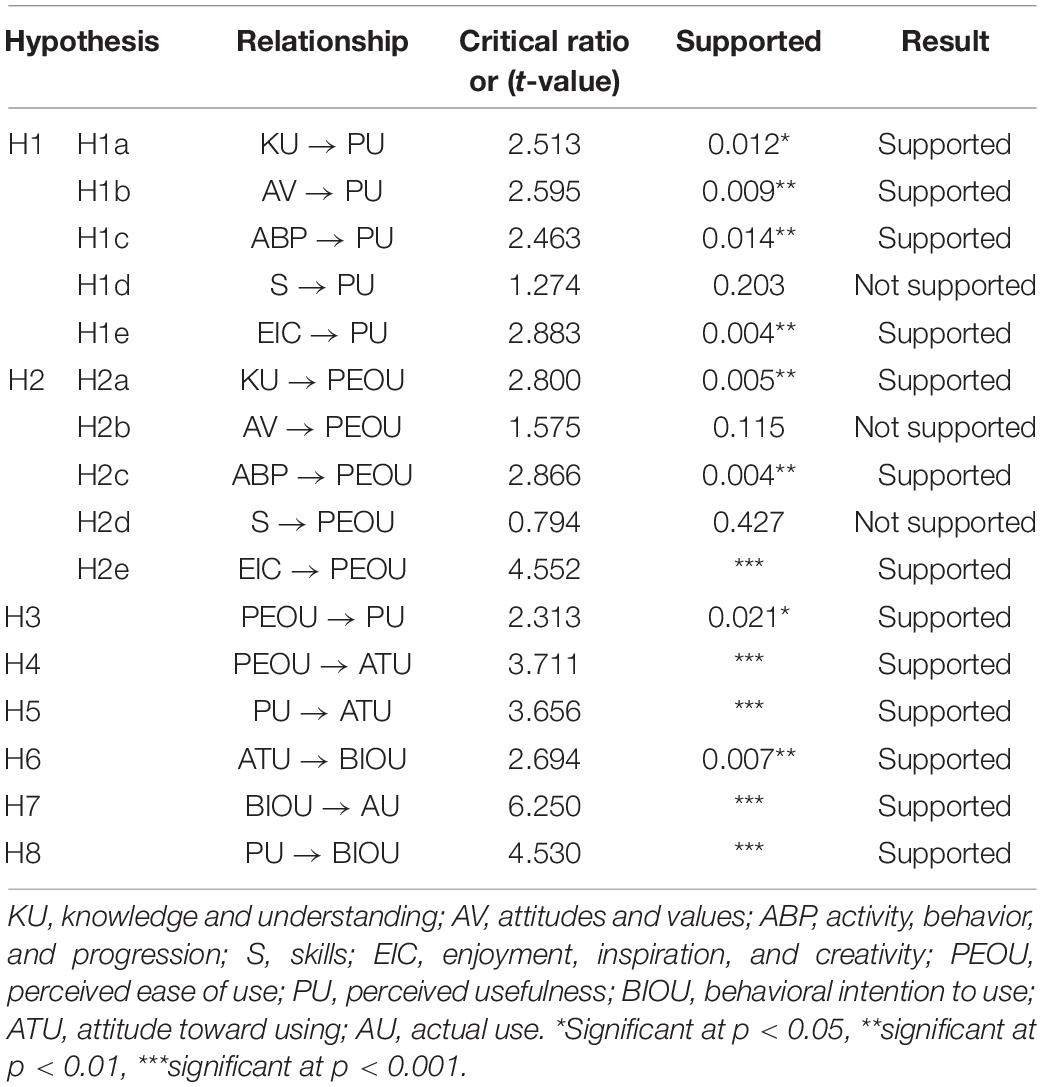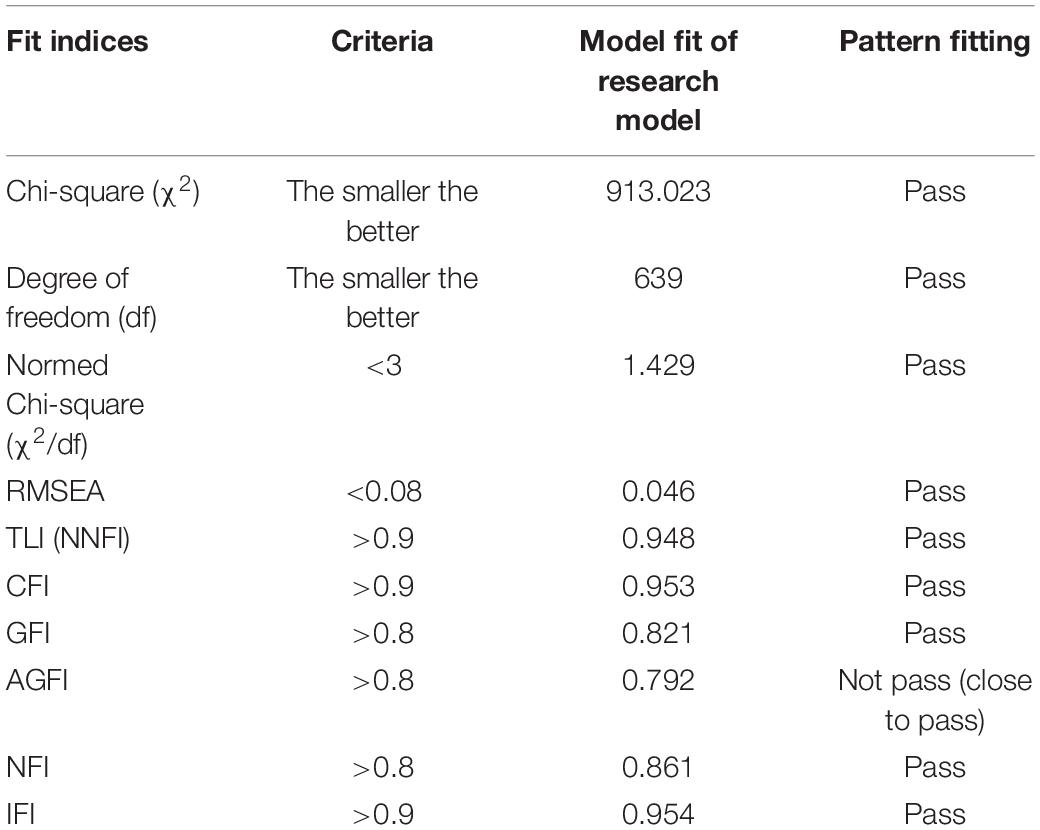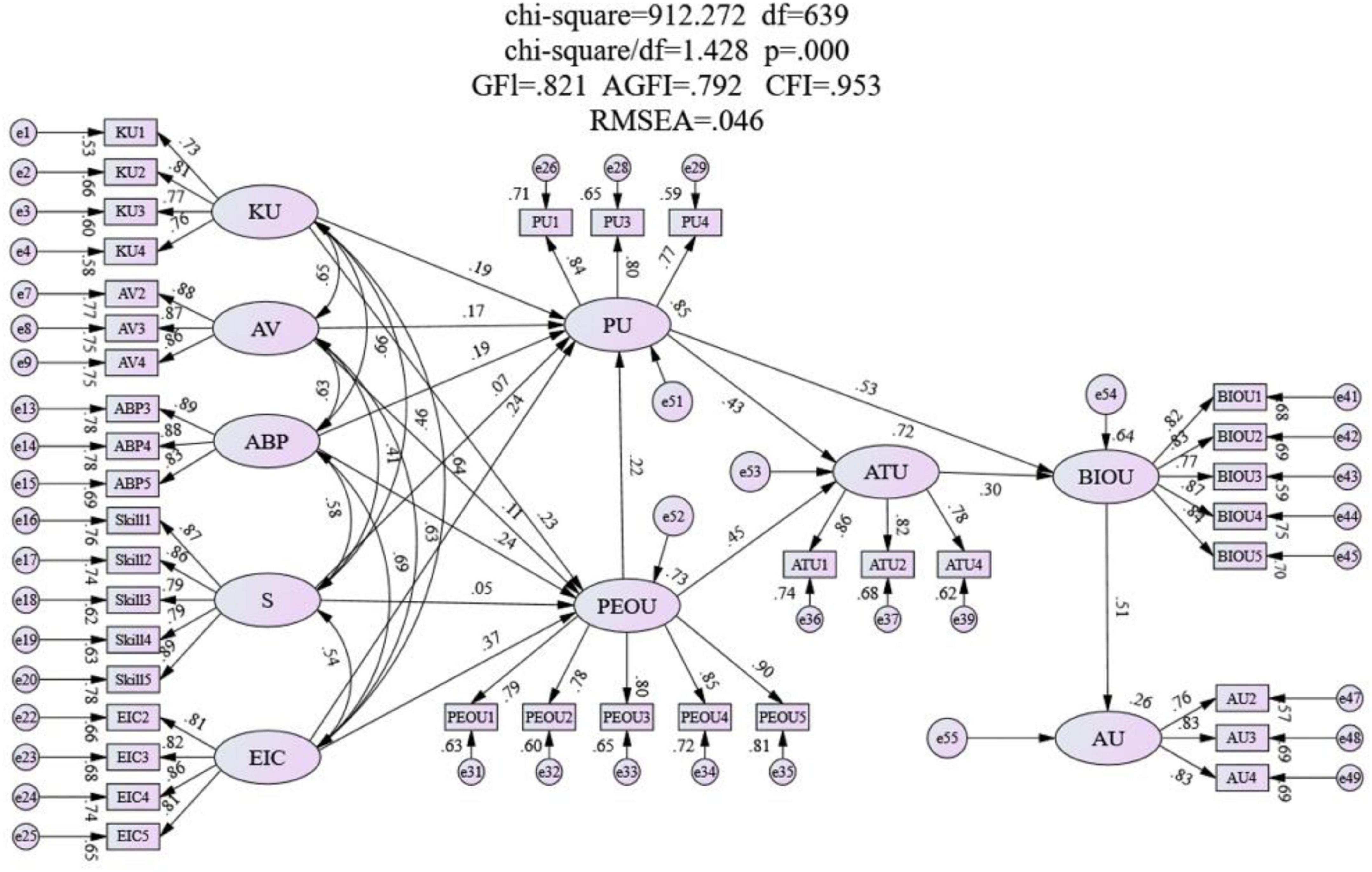- 1College of Design, National Taipei University of Technology, Taipei, Taiwan
- 2School of Design, NingboTech University, Ningbo, China
- 3Beijing United Gas Engineering & Technology Co., Ltd., Beijing, China
The lantern exhibition at the Lantern Festival is an important traditional festival in Taiwan. Visitors play an important role in the promotion and sustainable development of intangible cultural heritage (ICH). In recent years, the involvement of digital technology in traditional lantern design and shows has contributed to the protection, inheritance, and promotion of ICH, there remains less research on using augmented reality (AR) with ICH tourism. In this study, AR is used for ICH lantern exhibition to discuss the learning experience in lantern tourism and the relationship between technology acceptance and satisfaction from the perspective of visitors, as well as evaluate what AR has on improving visitors’ awareness and learning experience. Then, primary variables of the technology acceptance model (TAM) are combined with generic learning outcomes (GLOs) to integrate ICH, education, and technology to expand TAM, building a new model to study the ICH learning experience. A questionnaire and observation are used. Respondents are visitors participating in the AR lantern exhibition in Taiwan, which is designed by the author. There is a total of 200 questionnaires collected in the end. The result shows that knowledge and understanding (KU), attitudes and values (AV), activity, behavior, and progression (ABP), and enjoyment, inspiration, and creativity (EIC) from GLOs have a positive effect on technology acceptance and actual use (AU). Therefore, visitors are satisfied with innovative and interesting technology learning experiences, enhancing learning interest and results. Besides, the interaction of the AR system improves visitors’ learning motivation, which shows the combination of AR technology with ICH tourism helps improve cultural awareness.
Introduction
The protection and sustainability of intangible cultural heritage (ICH) is a major issue in the world (Anderson and Gerbing, 1988; Gössling, 2018; Lu et al., 2019; Tian et al., 2020). Governments should be committed to raising the awareness of people, especially young people about ICH and its significance (UNESCO, 2003). Lanterns were included in China’s Intangible Cultural Heritage Safeguarding List (China Intangible Cultural Heritage Website, 2018), leading to more attention to the traditional Lantern Festivals. It is believed that cultural heritage tourism is the best way to make people know more about the ICH, which can not only attract people to travel (Deacon, 2004; Rodzi et al., 2013; Masoud et al., 2019) but also disseminate local culture during festivals (tom Dieck et al., 2018; Li, 2020). It has been proved that study drives travel (Crompton, 1979; Mannell and Iso-Ahola, 1987; Prentice et al., 1998), and people’s desire for knowledge to decide where they go and what they do there (Crompton and McKay, 1997). The concept that cultural heritage tourism is combined with education is proposed (Ritchie, 2003). Tourism is considered an important driving force for lifelong learning, but its relationship with education remains to be studied (Falk et al., 2012).
In recent years, digital technology has been widely used in protecting ICH, such as augmented reality (AR), virtual reality, somatosensory interaction, 3D animation, holographic projection, and so on. Visitors can experience the cultural significance of ICH through these digital technologies, disseminating and effectively promoting ICH. To some degree, TAM can be used to show whether people accept the way ICH is shown through digital technology (Davis, 1989). How digital technology affects visitors’ reactions, behaviors, and psychology is paid more attention (Han et al., 2021). So far, TAM has been developed, researched, and widely used in education. Academically, TAM has a dramatic effect on teachers and students (Tan and Hsu, 2018), while generic learning outcomes (GLOs) provide a framework for planning and evaluating visitors’ learning results after the visit.
There is a growing concern about the effect of digital technology on visitor experience across academic communities but they seldom study about how digital technology is applied to the ICH learning experience. Therefore, an AR system is developed for visitors based on the ICH lantern learning experience in this study. In this way, visitors can interact with lanterns, and discuss the learning experience and relationship between technology acceptance from their perspective.
Theoretical Background
Non-formal Learning in Intangible Cultural Heritage Tourism
As the traditional culture is being destroyed (Lu et al., 2019), the ecology of culture diversity loses balance. Education can effectively protect, inherit, and disseminate ICH (UNESCO, 2003) through formal learning at school and non-formal learning outside school, such as museums, exhibitions, and tourism. Learning ICH at school helps protect and inherit the traditional culture (Olanipekun et al., 2015; Abisuga-Oyekunle and Fillis, 2017). However, learning it in an informal environment also plays an important part (Falk et al., 2012), because public involvement contributes to the heritage of ICH (Yan and Chiou, 2021). Non-formal learning in the form of travel facilitates personal practical skill, knowledge, and intelligence, facilitating their intelligence, cross-cultural awareness, and professional development (Falk et al., 2012). In the past decade, cultural heritage tourism has played a more and more important part (Abuamoud et al., 2014). With the help of technology, visitors can know more about the environment, culture, religion, tradition, and history when traveling, and improve their learning experience through different forms of communication technology (Mortara et al., 2014).
The Lantern Festival is the day of the first full moon after the Spring Festival. Since 1990, Taiwan has held lantern exhibitions at the Lantern Festival every year, and 32 shows have been conducted up to now (Taiwan Tourism Bureau, 2021). At the Lantern Festival, various lantern competitions will be held across Taiwan, where different lantern works will be shown, aiming at inheriting lantern crafts. Recently, the lantern exhibition has been combined with technology and city tours, providing the public with more involvement and innovation (Li, 2020), and becoming a symbol of Taiwan. In 2020, for the first time, lantern exhibitions were held in two districts of Taipei. A total of 45 lantern stalls featuring a wide variety of lanterns attracted 2,834,939 visitors (Taipei City Government, 2020; see Figure 1). The lantern exhibition during the Lantern Festival is an ancient folk activity in the Chinese culture and has a long cultural tradition and strong cultural characteristics. The inheritance, protection, and transmission of ICH need the participation of all of the public. Media and education are important ways to spread ICH (Yang, 2017). To bring our excellent traditional culture into life, education is the first and the only way to protect the ICH.
In recent years, there have been discussions about how to measure the learning outcomes of non-formal learning. Learning outcomes refer to what the learning has achieved. It may be short term or long term, depending on personal understanding (Hooper-Greenhill et al., 2003). Bitgood and Loomis (1993) assumed that it was important to value visitors’ experiences. An increasing number of museums realize that experience was an important factor to affect experience value and visitors’ satisfaction (Rowley, 1999). As a result, they attach great importance to visitor-centered experience, which also drives the development and evolvement of measurement tools. These tools try to analyze the learning outcomes of visitors from different perspectives. Among them, the Learning Impact Research Project is one of the most representative. This project was entrusted to the Research Centre for Museums and Galleries, University of Leicester by the Museums, Libraries and Archives Council in 2001. This center proposed GLOs (Hooper-Greenhill et al., 2003; Hooper-Greenhill, 2004; Su, 2020), and hoped that museums, libraries, and galleries used this tool to measure the learning outcomes of non-formal learning.
Generic learning outcomes have become a framework for evaluating arts and culture, and consist of five parts: (1) knowledge and understanding (KU), (2) skills, (3) attitudes and values (AV), (4) enjoyment, inspiration, and creativity (EIC), and (5) activity, behavior, and progression (ABP), each of which plays an important part (Arts Council England, 2021). GLOs are designed as a tool for museums, libraries, and archives (Monaco and Moussouri, 2009, p. 318) to understand the learning outcome. Many scholars seek to use GLOs to measure the learning outcome and experience of visitors during the show (Leue et al., 2015; tom Dieck et al., 2018). Many studies about visitors’ learning experience focus more on specific learning environments, such as museums, sites, and zoos (Moscardo, 1996; Prentice et al., 1998; Falk and Dierking, 2000; Packer, 2006), or visitors, such as backpackers, cultural tourists, and the elderly (McKercher, 2002; Roberson, 2003; Pearce and Foster, 2007), but less on outdoor festival activities. About GLOs, learning outcomes are measured by asking learners (Hooper-Greenhill et al., 2003; Hooper-Greenhill, 2004). In this study, GLOs are combined with the technology acceptance model (TAM) to measure non-formal learning outcomes during lantern tours.
Improving the Learning Experience of Intangible Cultural Heritage Tourism Through Digital Technology
Digital technology can improve visitors’ knowledge and skills about traditional lantern crafts during their tours. Many scholars have recently introduced digital technology to ICH shows, education, promotion, dissemination, and inheritance. For example, embodied and tangible interaction is always used for ICH learning and inheritance in the field of performing arts (dance and drama) (Grammatikopoulou et al., 2019). AR combines “real image” with “virtual computer image,” making users operate virtual 3D or 2D objects in a visible real-world environment. It has been widely used in education (Martin et al., 2011). AR experience raises visitors’ awareness of protecting cultural heritage (Han et al., 2021). It was found that students would pay more attention to learning in education with AR, thus improving their learning experience (Santos et al., 2014; González Vargas et al., 2020), which could further enhance knowledge acquisition (Moorhouse et al., 2019). AR enhances interaction, involvement, and individuation (Leue et al., 2015). The learning experience of visitors with handheld devices is different from that without handheld devices (Mikalef et al., 2012; Leue et al., 2015). The mobile makes museum apps and gallery apps accessible and improves visitors’ personalized and interactive experiences (Chang et al., 2015).
Digital technology can effectively improve the ICH learning experience. Some scholars have applied VR to social practices, rituals, and festival events. They transformed oral traditions into the real world, where visitors can involve themselves in virtual festivals or stories (Chang, 2015; Skovfoged et al., 2018). In this way, visitors’ satisfaction will be improved by combining ICH with the sightseeing tour, which will in turn make visitors more loyal to ICH tourism (Tian et al., 2020).
Garzón et al. (2019) sorted 64 articles about AR and education between 2010 and 2018 and found that AR had a dramatic impact on students’ learning outcomes, especially in engineering, arts, and humanities. Students are more willing to participate in learning in this learning environment with AR (Damala et al., 2008; Dunleavy et al., 2009). Therefore, AR is the potential to improve the tourism experience (Chung et al., 2015; Jung et al., 2015).
Digital technology is valued in user experience, of which the TAM receives the most attention. TAM is normally used to evaluate how users accept new technology and key factors affecting users (Davis, 1989). TAM is widely used in education (Elwood et al., 2006; Alenazy et al., 2019), and focuses on perceived usefulness (PU), perceived ease of use (PEOU), social influence, attitude toward using (ATU), and actual use (AU) (Davis, 1989). PU and PEOU decide behavioral intention and attitude. TAM is under development and expansion, such as TAM 2 (Venkatesh, 2000; Venkatesh and Davis, 2000) and TAM 3. Given TAM 2, a unified theory on technology acceptance and use is linked to e-commerce (Venkatesh et al., 2003). TAM 3 is used to evaluate what decides using intention and behavior in an e-learning environment (Venkatesh and Bala, 2008). As AR technology is widely used in tourism, visitors gained more knowledge. At the same time, there were many problems, including whether knowledge transfer is done, and how users accept the technology and the technical level of AR. Therefore, it is very important to know how users accept AR technology, and what decides and influences its acceptance.
Sustainability of Intangible Cultural Heritage
The core of protecting ICH is enhancing its vitality and sustainability (Lenzerini, 2011). Combining ICH protection with tourism will generate a new protection form (Zandieh and Seifpour, 2020). In recent years, tourist attractions and travel agencies provide ICH experience tours to enhance the ability to integrate ICH across borders (Su et al., 2020), and respect for cultural diversity and human creativity, producing a sense of identity (UNESCO, 2003). ICH has been reshaped when adapting to different communities and populations and surroundings and interacting with its history. Studies revealed that learning has a positive effect on ICH sustainability (Gössling, 2018), such as maintaining cultural vitality and empowering people with knowledge to ensure ICH’s sustainability (Grant, 2012). Experience replaces goods and services (Pine et al., 1999), and becomes the main factor in driving economic development. Creative cultural experience will have a positive effect on visitors’ experience and well-being. Visitors who participate in the cultural experience feel like improving their cultural awareness (Ismagilova et al., 2015). Ritchie and Hudson (2009) indicated that one of the challenges travel planners face is tourist experience design. The sustainability of ICH is characterized by “tourism + education + technology” in the new era.
Summary
Above all, the Lantern Festival is an important traditional festival in Chinese culture, and lanterns are one of the major elements. As human’s ICH, this kind of culture needs to be inherited and transmitted by way of education. The education, in turn, promotes learners to learn more through experiential learning, including physical experience, touching, and understanding, to inherit and transmit ICH.
Nowadays, technologies are involved in ICH in many studies, which are also focused on whether users learn and understand cultures during the interaction experience. Especially, studies about the inheritance of tangible cultural heritages are rarely based on ICH, especially the traditional festival ceremonies. Therefore, targeting the culture of the Lantern Festival, this study explores the application of digital technology in ICH. Regarding digital technology, this study combines AR technology with mobile devices because the Lantern Festival is an outdoor activity. Understanding users’ experience about new technology helps to gradually build the relationship between ICH and digital technology, and create a suitable relationship model.
This study discusses the relationship between interactive technology and the inheritance and transmission of ICH. Targeting the culture of the Lantern Festival, this study combines AR technology and mobile device. GLOs and TAM are used to measure users’ learning outcomes for ICH and during the AR Lantern Festival.
Research Methodology and Hypotheses
Relevant literature review shows that AR can enhance visitors’ experience on ICH, but seldom studies are about learning outcomes of AR experience. This study explores the learning experience and relationship between AR acceptance with AR applying to ICH tourism from the perspective of visitors, as well as discusses the value and GLOs of AR lanterns and the relationship between technology acceptance. A questionnaire is an effective way to understand visitors’ experiences (tom Dieck et al., 2018; Othman et al., 2021). In this study, a lantern interaction system is designed to collect questionnaires and analyze study data after the ICH lantern exhibition at the Lantern Festival.
In this study, lantern AR interactive system (LARIS) is designed to get visitors’ experiences on exhibition. To collect and analyze relevant data, questionnaires are distributed to visitors after they experience ICH lantern exhibition. To be effective, questionnaires must be distributed after the exhibition (tom Dieck et al., 2018; Othman et al., 2021). Finally, a semi-structured interview is taken to get visitors’ deep insights about this experience. To supplement the quantitative data, qualitative analysis is made.
Participants
This study was conducted during the lantern exhibition of the Lantern Festival in 2020. Researchers recruited 200 visitors, and all of them were willing to fill the questionnaires and signed informed consent forms. Participants were 18–60 year olds and were proficient in the traditional Chinese. Therefore, all materials are in traditional Chinese.
This study was conducted under the support of the Taiwan Ministry of Education. Involving no human experiment and the vulnerable in this study, only visitors were required to sign informed consents. The informed consent is divided into 12 parts: which are, respectively, study objectives; conditions and restrictions on participation; study methods and procedures; potential risks, occurrence, and remedies; efficiency and benefits for participants; contraindications and restrictions; shelf life, application, and confidentiality of research materials; compensation for damages; data processing technique after the end of the study; withdrawal from the study and how to process its data; commercial benefits derived from the study and its extended applications; rights; signature. The informed consents are in Chinese.
Interaction Design
During the 2020 lantern exhibitions at the Lantern Festival in Taiwan, LARIS was designed. With LARIS, visitors can get a description of the lantern they see. Its instructions are shown in Figure 2. Step 3 shows that you should align the lens with the image target (religious icon and religious lanterns), that is, a Muslim woman with a turban. Step 4 is what you get after scanning, where visitors know more about religious icons and religious lanterns (Figure 2).
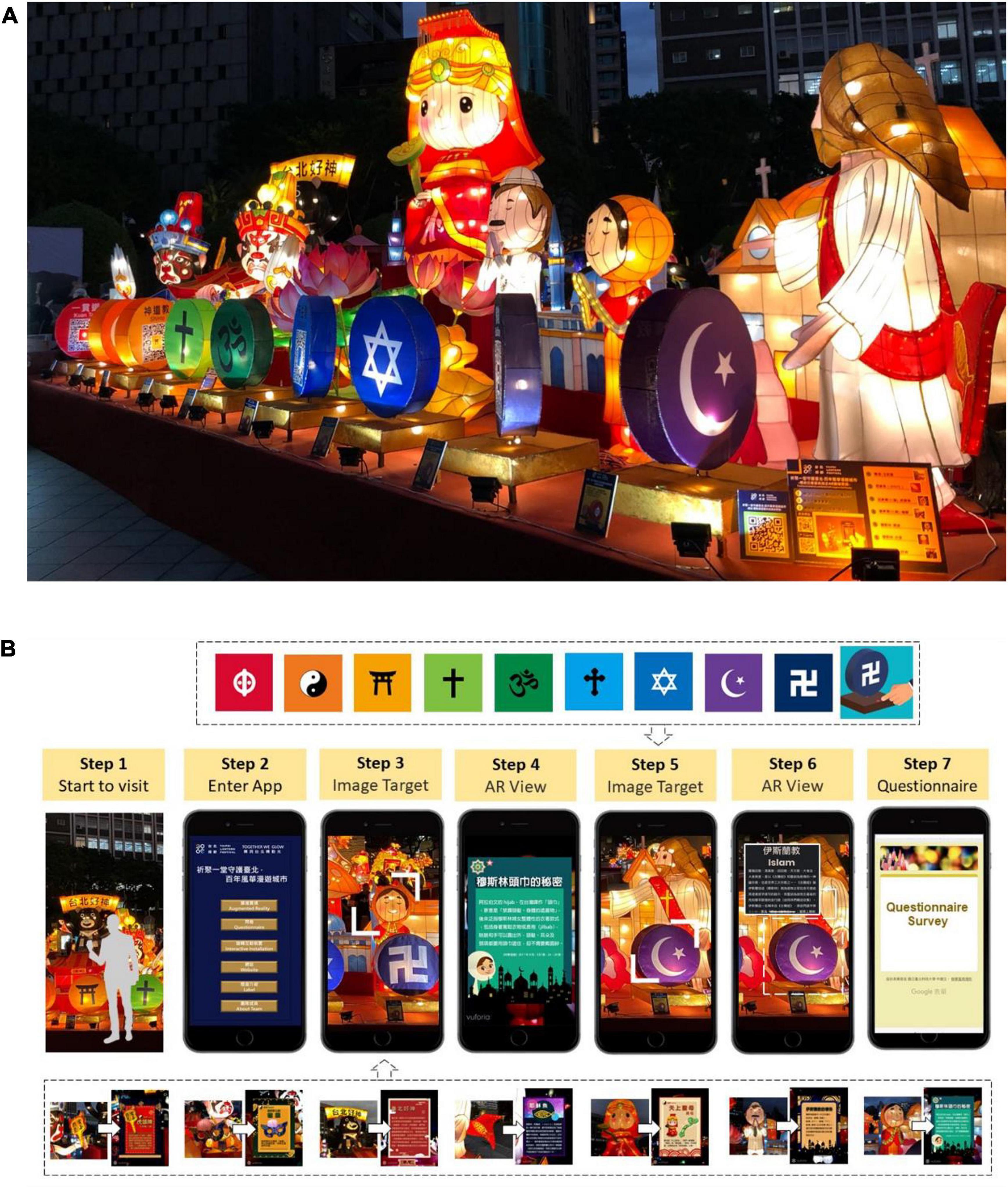
Figure 2. (A) Augmented reality lantern interactive design; (B) lantern AR interactive system (LARIS) use process.
Questionnaire
The questionnaire is modified based on previous studies and experts’ advice to make it more efficient. It is divided into two parts: GLO items (Hung, 2014; Su et al., 2017; tom Dieck et al., 2018; Su, 2020; Li et al., 2021); and technology acceptance measurement items (Davis, 1989; Meng et al., 2018; Choi et al., 2019; Venkatesh, 2000; Venkatesh and Davis, 2000; Venkatesh et al., 2003). Its contents were checked by four experts, of whom two were museum planning curation experts, one was a HCI researcher and one was a lantern craftsman.
Likert scale was used, that is, strongly disagree, disagree, a little disagree, not sure, a little agree, agree, and strongly agree (Table 1). The study data were analyzed with SPSS 25.0 and AMOS 23.0, including confirmatory factor analysis (CFA) and structural equation modeling (SEM).
Hypothesis Development
Users will be affected by many factors when faced with new technology. These factors include PU, PEOU, behavioral intention to use (BIOU), ATU, and AU. PU refers to whether people think technologies are useful for him. PEOU refers to a specific system that can save people much energy (Davis, 1989; Venkatesh and Bala, 2008). BIOU is decided by ATU which refers to the general impression on technologies (Sun et al., 2008). PEOU will affect PU and is directly related to ATU, BIOU, and real system use (Esteban-Millat et al., 2018). PU is considered the most important factor to affect users’ technology acceptance.
It is assumed that PU and PEOU are key driving factors in TAM variables. Besides, a TAM 2 framework was put forward, which revealed that cognitive tools affected PU, determining a person’s intention to use information systems finally (Venkatesh and Davis, 2000). With improvement, TAM 3 is built and shows the great differences between behavioral intention and using behavior (Venkatesh and Bala, 2008; Al-Gahtani, 2016). The relation between behavioral intention and user behavior has been built (Chuan-Chuan Lin and Lu, 2000). It is important to know what decides PU and its change with time and system use because they determine the AU. There are also external factors that affect PU and PEOU. In this article, GLOs of visiting AR lantern exhibitions are discussed as an external factor of the TAM framework. It also confirms the relevance of indicators above to various aspects of TAM and puts forward the hypotheses as given in Figure 3. A detailed explanation of the constructs and the justifications for the proposed hypotheses are highlighted in the following sections.
Davis (1989) pointed out that external variables enhanced the ability of TAM to predict people’s technology acceptance in the future, and might impact PU and PEOU. His idea was proved by many studies (Zare and Yazdanparast, 2013; Agudo-Peregrina et al., 2014) later. Bandura (1986) assumed that self-efficacy referred to a set of beliefs we hold about our ability to complete a particular task, evaluate self-competence and behavior, and self-influencing. The higher the self-efficacy is, the better people behave (Wang, 2020). For Wilhite (1990), academic self-efficacy refers to a kind of belief students hold about their ability to master learning behavior outcomes from the perspective of students’ learning. As is shown in many studies, academic self-efficacy will affect the PEOU and PU of new technology (Sánchez and Hueros, 2010; Fathema et al., 2015; Thongsri et al., 2020). Besides, GLOs are used to explore how AR technology affects visitors’ subjective learning outcomes (tom Dieck et al., 2018), which show that AR technology can enhance visitors’ understanding and value, improve their skills, increase their enjoyment and creativity, and affect their future behavior. Domain knowledge has a positive effect on PEOU (Thong et al., 2002), and perceived enjoyment influences PU and PEOU (Tao et al., 2019). Enjoyment will impact the user’s perceived value (Kim and Park, 2019). As is shown in previous studies, if users enjoy new technology, it will have a positive effect on PU and PEOU (Al-Aulamie et al., 2012). Therefore, subjective learning outcomes can be used to understand external variables of PEOU and PU is very important in explaining users’ technology acceptance. As a result, supposing that:
Hypothesis 1 (H1): Knowledge and understanding (KU) (H1a), skill (S) (H1b), enjoyment, inspiration, and creativity (EIC) (H1c), attitudes and values (AV) (H1d), and activity, behavior, and progression (ABP) (H1e) are positively correlated to perceived usefulness (PU).
Hypothesis 2 (H2): Knowledge and understanding (KU) (H2a), skill (S) (H2b), enjoyment, inspiration, and creativity (EIC) (H2c), attitudes and values (AV) (H2d), and activity, behavior, and progression (ABP) (H2e) are positively correlated to perceived ease of use (PEOU).
Perceived ease of use and PU are basic structures in TAM. Many studies confirm that PEOU has a dramatic impact on PU (Ayeh et al., 2013; Letchumanan and Muniandy, 2013; Abdullah et al., 2016; Hadi et al., 2022). As a result, supposing that:
Hypothesis 3 (H3): Perceived ease of use (PEOU) is directly and positively correlated with perceived usefulness (PU).
Whether this technology is feasible depends on users’ attitudes toward it (Fan, 2020). The relationship between PEOU and PU and ATU is based on the theory of reasoned action. According to this theory, PEOU and PU significantly affect ATU (Davis, 1989; Esteban-Millat et al., 2018). As a result, supposing that:
Hypothesis 4 (H4): Perceived ease of use (PEOU) is directly and positively correlated with attitude toward using (ATU).
Hypothesis 5 (H5): Perceived usefulness (PU) is directly and positively correlated with attitude toward using (ATU).
High TAU will affect users’ BIOU (Chung et al., 2015; Abdullah et al., 2016; Cheng and Yuen, 2018). If users have a good attitude toward the AR experience, they will have highly positive feelings, experiencing it again. Therefore, users’ high ATU for AR may affect its BIOU. As a result, supposing that:
Hypothesis 6 (H6): Attitude toward using (ATU) is positively correlated to behavioral intention to use (BIOU).
Behavioral intention to use refers to users’ intention to use the new system. The use of new technology depends on the users’ behavioral intention (Esteban-Millat et al., 2018). As is shown in previous studies, BIOU has a direct and significant effect on AU (Esteban-Millat et al., 2018; Salloum et al., 2019). As a result, supposing that:
Hypothesis 7 (H7): Behavioral intention to use (BIOU) is positively correlated to actual use (AU).
Davis (1989) said, if some kinds of technology could improve users’ working or learning performance, he would have a high BIOU. As a result, supposing that:
Hypothesis 8 (H8): Perceived usefulness (PU) is positively correlated to behavioral intention to use (BIOU).
Data Collection and Analyses
A total of 202 visitors who participated in this study from the AR lantern exhibition were selected randomly between 8 and 16 February 2020. A total of 200 questionnaires were obtained finally except for 20 invalid questionnaires. The tourists were coded from V1 to V200. Then, SPSS 22.0 was used to make descriptive statistical analysis, and AMOS 23.0 was used to make SEM for fitting discussion and relationship among variables.
Results
Sampling was done as the first test before a formal test with Cronbach alpha taking 0.956. If the result is greater than 0.7, the reliability is high (see Table 2).
Profile of Participants
As is seen in Table 3, the female visitors account for 67% (133), while the male visitors were 34% (67). Most of them were 31–40 year olds accounting for 33% (66). Visitors at the age of 21–30 years constituted 25% (50); visitors at the age of 41–50 years account for 25% (50); visitors at the age of 51–60 years were 12% (24) and visitors under 20 years old represented 5% (10). This exhibition successfully attracted many visitors who had never visited the lantern exhibition at the Lantern Festival.
Measurement Model Verification
The measurement model of this study will be tested for validity, which is convergent validity and discriminant validity.
Measurement Model Verification
In this study, SEM, which is proposed by Anderson and Gerbing (1988), is used to evaluate and measure structural models. This method is divided into two steps. The first step aims to check the reliability and efficiency of CFA, and the second aims to measure path effects and their significance to the structural model. In the measurement model, maximum likelihood estimation (MLE) is used to evaluate factor loading, measurement reliability, convergent validity, and discriminant validity. Table 4 shows non-standard factor loading, standard factor loading, standard error, significance test, square multiple correlations, composite reliability (CR), and average variance extracted (AVE). Given all the questions of questionnaires, the standard factor loading was reasonable, ranging from 0.726 to 0.902, which shows the convergent validity. The CR is between 0.847 and 0.923, which is more than 0.7, a value recommended by Nunnally (1994). It shows the internal consistency of SEM. AVE value ranges from 0.604 to 0.821, more than 0.5 recommended by J. F. Hair, Anderson, Tatham, William, Fornell, and Larcker. It shows sufficient convergent validity (Fornell and Larcker, 1981; Anderson and Gerbing, 1988). Internal consistency is based on the relevance of different projects of the same test and is used to measure whether study items will generate similar scores.
Measurement Model Verification
Discriminant validity is used to judge the validity of different constructs and confirm whether the relevance of different constructs is different significantly. It can be achieved by comparing the square root of AVE and the relevance of different constructs (Fornell and Larcker, 1981; Segars and Grover, 1998). The coefficient proposed by Fornell and Larcker (1981) is more than 0.5, which shows the high internal consistency. Their high relevance means that things measured by them are the same. The standards above show that the AVE of each question of the questionnaire is more than 0.5, and the square root of AVE is more than the relevance coefficient of variables, which shows the better convergent validity and discriminant validity between various variables (Table 5).
Hypotheses Test
Hypothesis 1: In the analysis of the relation between GLOs and PU, PU is a dependent variable, and the following are independent variables aiming to determine the relative effect of various variables: knowledge and understanding (KU) (H1a), attitude, value, and enjoyment (AV) (H1b), actions and behavior change (ABP) (H1c), skills (S) (H1d), and enjoyment, inspiration, and creativity (EIC) (H1e). The results show that S (H1d) (B = 0.070, t = 1.274, p > 0.05) is not significantly affected, and therefore, H1d is assumed to be null without discussion. The independent variables below significantly affect PU: KU (H1a) (B = 0.193, t = 2.513, p < 0.05*), AV (H1b) (B = 0.174, t = 2.595, p < 0.01**), ABP (H1c) (B = 0.195, t = 2.463, p < 0.05*), and EIC (H1e) (B = 0.237, t = 2.883, p < 0.01**). The study confirmed that the hypotheses of H1a, H1b, H1c, and H1e are the case. After visiting lantern exhibitions with the AR system, visitors’ PU will be affected by KU, AV, ABP, and EIC, which will improve visitors’ PU when they visit lantern exhibitions with the AR system (Table 6).
Hypothesis 3: PEOU is taken as an independent variable and PU is taken as a dependent variable. The result shows that PEOU significantly affects PU (B = 0.219, t = 2.313, p < 0.01**) (Table 6), which indicates that H3 is the case where the PEOU of visitors will improve the PU.
Hypothesis 2: In the analysis of the relation between GLOs and PEOU, KU (H1a), AV (H1b), ABP (H1c), skills (H1d), and EIC (H1e) are taken as independent variables, and PEOU is taken as dependent variable to determine the relative effect of variables. The result showed that AV (H2b) (B = 0.114, t = 1.575, p > 0.05) and S (H2d) (B = 0.047, t = 0.749, p > 0.05) did not significantly affect PEOU. Therefore, H2b and H2d were not the cases, and there was no point in discussing. KU (H2a) (B = 0.226, t = 2.800, p < 0.01**), ABP (H2c) (B = 0.239, t = 2.866, p < 0.01**), and EIC (H2e) (B = 0.375, t = 4.552, p < 0.001***) significantly affected PEOU (Table 7), which confirmed that H2a, H2c, and H2e were the cases.
After visiting lantern exhibitions with the AR system, the PEOU of visitors would be affected by KU, ABP, and EIC, which would improve visitors’ PEOU when they visit lantern exhibitions with the AR system.
Hypothesis 4: PEOU is taken as an independent variable, and ATU is a dependent variable. The result showed that PEOU significantly affected ATU (B = 0.445, t = 3.711, p < 0.001***). Therefore, H4 is the case, that is, the PEOU of visitors when visiting lantern exhibitions with the AR system will directly affect ATU (Table 8).
Hypothesis 5: PU is taken as an independent variable and ATU is taken as a dependent variable. The result showed that PU would significantly affect ATU (B = 0.440, t = 3.656, p < 0.001***). Therefore, H5 is the case, that is, the PU of visitors when visiting lantern exhibitions with the AR system will directly affect ATU (Table 8).
Hypothesis 8: PU is taken as the independent variable and BIOU is taken as the dependent variable. The result showed that PU will significantly affect BIOU (B = 0.528, t = 4.530, p < 0.001***). H8 is the case, that is, the PU of visitors when visiting lantern exhibitions with the AR system will directly affect BIOU (Table 9).
Hypothesis 7: BIOU is taken as the independent variable and AU is taken as the dependent variable. The results show BIOU will significantly affect AU (B = 0.508, t = 6.250, p < 0.001***). H7 is the case, that is, the BIOU of visitors when visiting lantern exhibitions with the AR system will directly affect AU (Table 10).
As is shown in Figure 4, H1a, H1b, H1c, H1e, H2a, H2c, H2e, H2, H3, H4, H5, H6, H7, and H8 is the case after statistical verification.
Summary of Hypothesis Testing
In this study, 8 hypotheses were proposed, and are subdivided into 12 parts, of which 8 are supported and the rest are not supported (Table 11).
Structural Equation Modeling
Structural Equation Model Analysis
The overall model fit must be judged to verify the hypotheses. Schumacker and Lomax (2004) and Kline (2015) noted that model fit will be adversely affected with p less than 0.05 if it is analyzed with large quantities of samples. As a result, different methods should be used in a quantitative study to check model fit. In this study, generic models, which apply to verification methods, were implemented (Jackson et al., 2009). Based on these models, if Chi-square is divided into degree of freedom (df), the result is less than 3 ideally. Besides, other standards require stricter values in model fit verification, such as RMSEA value should be less than 0.08 (Hu and Bentler, 1999), the value of CFI standard should be more than 0.9. As is shown in Table 12, all model fitting standards which are tested conform to the recommended standard (Schumacker and Lomax, 2004).
As is shown in Table 12, fit indices showed a better model fit, except for AGFI. AGFI was equal to 0.792, which is a little less than the standard value but close to 0.9. Therefore, its complexity remains to be improved and it is necessary to make a deep study in the future to define models. All in all, the structural equitation model is valid and matches the recycled data better, because most of the absolute indices meet the standard (GFI = 0.821, NFI = 0.861, IFI = 0.954, CFI = 0.953, TLI = 0.948).
Path Analysis
According to the path coefficient shown in Table 13, 85.3% of PU is related to KU, AV, ABP, S, EIC, and PEOU; 73.3% is related to KU, AV, ABP, S, and EIC; 63.9% of BIOU is related to ATU and PU; and 25.8% of AU is related to BIOU, which shows that the model is valid. Figure 5 shows the validity result of SEM.
In this study, GLOs and TAM are combined and the result shows that KU, AU, ABP, and EIC significantly affect EIC. Besides, KU, ABP, and EIC significantly affect PEOU. PEOU significantly affects PU and ATU. PU significantly affects ATU. ATU significantly affects PU and BIOU. BIOU significantly affects AU. The model structure is shown in Figure 5.
Enjoyment, inspiration, and creativity play an important role in the experience. In the non-formal learning environment in the form of ICH tours, visitors are usually affected by emotions (Falk et al., 2012). New technology expands people’s imagination and creativity. With technology, people can create a joyful and practical learning environment in tourist attractions where PU, PEOU, ATU, and BIOU will be affected, improving AU, and making them learn some culture.
Discussion
In this study, AR was applied to lantern exhibitions at Taiwan Lantern Festival to explore the characteristics of ICH tours in the era of the experience economy. Besides, questionnaires based on GLOs, TAM, accompanied by data collected were used. The result is shown below.
First, external variables impact PU and PEOU (Davis, 1989). With regard to external variables, KU, AV, ABP, and EIC have a significantly positive effect on PU and PEOU. It shows that the focus should be on KU, AV, ABP, and EIC when creating a new experience with AR. With its interaction, AR has become the best medium to convey information, thus having a great advantage in exhibition design. EIC has the most significant effect on PEOU, which is the same as the previous study results (Al-Aulamie et al., 2012; Kim and Park, 2019; Tao et al., 2019). Echoing its features, AR inspires visitors’ interest in its use and brings EIC, thus improving cultural awareness (Cranmer, 2019) and affecting future behavior (tom Dieck et al., 2018). Therefore, it is suggested that users should enjoy a vivid and interesting experience for ICH tours when digital technology is used to design the tour, improving their cultural awareness of ICH. Besides, study results show that skills will not affect PU and PEOU. This is because the description of skill dimensions is vague in GLOs, and it is hard to tell that they are technical learning, skill learning in knowledge, or skill learning with technology products. Thus, it is suggested that skills should be deleted in future studies where GLOs are used to measure ICH learning.
Second, with respect to TAM construction, results show that PEOU has a significantly positive effect on PU and ATU, which is corresponding with the original theoretical foundations of TAM (Davis, 1989). When visitors consider the AR system useful, their usefulness and attitude will undoubtedly increase. According to these results, PU has a significantly positive effect on ATU and BIOU, which is corresponding with previous studies (Davis, 1989; Esteban-Millat et al., 2018; Fan, 2020). When visitors consider the AR system useful, their attitude and behavioral intention will be better, which is corresponding with previous studies (Davis, 1989; Chung et al., 2015; Abdullah et al., 2016; Cheng and Yuen, 2018; Salloum et al., 2019). In addition, when visitors have a positive attitude toward the AR system, their BIOU AR will increase, thus improving visitors’ intention to use the AR system.
Third, with regard to AR technology, visitors found it hard to recognize some images with mobile devices, which is caused by the light of the environment and works displayed. González Vargas et al. (2020) pointed out that AR applications may be affected by lighting conditions. This is because the Lantern Festival is a kind of outdoor activity and will be affected by light on site. Besides, lanterns displayed themselves are illuminants, making it harder to recognize the images. In the future, importance should be attached to enhancing lanterns’ visibility to create more different visual effects.
Fourth, as is shown in the data, most visitors (73%) have surprisingly never gone to lantern exhibitions during the Lantern Festival. The Lantern Festival is a Chinese traditional activity, during which lantern exhibitions will be held in various cities. Dou et al. (2018) said that most of the public is not interested in ICH. However, when traditional lanterns are combined with AR technology, the exhibition successfully attracts a lot of visitors. It demonstrates that new media technology can improve visitors’ motivation to participate in ICH activities (Lo et al., 2019; Moorhouse et al., 2019) and give them a meaningful learning experience (Hsu and Liang, 2017; González Vargas et al., 2020), raising their cultural awareness (Lo et al., 2019).
Finally, many visitors indicated in their experience feedback that AR technology enhances visitors’ interaction with traditional lanterns. When a 2D image is shown on the mobile phone screen, visitors’ curiosity is inspired (Moorhouse et al., 2019), so they will keep using this system. As is said by V1, it was interesting to combine traditional lanterns with AR technology, making him want to complete all tasks. Additionally, it inspired visitors to change their behaviors toward ICH culture learning (Leue et al., 2015; Huang, 2019; Lo et al., 2019). It even inspired V2, V25, and V80 to know more about how to make lanterns. More importantly, the AR system inspired visitors’ positive experience behavior (Moorhouse et al., 2019; González Vargas et al., 2020). P105, P112, and P185 said, they had never seen the combination of AR technology with traditional lantern exhibitions, and wanted to experience and know more about it. Besides, V32 took part in it with their children, saying that the combination of AR and ICH tourism was a way for the public to know more about culture and learn about cultures with their children.
Conclusion
This study contributes to the application of AR to the ICH tourism experience and the integration verification for GLOs and TAM. Results show that external variables, including KU, AV, ABP, and EIC, have a significant effect on PU and PEOU, and ATU and PU directly decide the intention to use AR. Finally, BIOU determines visitors’ actual usage.
This study explores the relationship between new technology and learning experience more completely than previous studies. The model developed in this study is useful for future reference in the application of digital technology to the tourism experience. In this study, learning is not limited to specific activity or device, thus it provides a user experience regardless of studying the impact of learning outcomes or tourism experience.
As a protector and transmitter, the public plays an important role in promoting sustainable ICH (Yan and Chiou, 2021). Cultural tourism will affect tourists’ cultural awareness and learning (Ismagilova et al., 2015). Therefore, it is a must to attract the public. As the gene of our national culture, ICH is particularly important for the development of human culture, social economy and civilization, and personal and national identity.
Research Limitations and Future Work
This study is limited in several aspects. In terms of experimental samples, its size is small with only 200 visitors. This is because the number of visitors attending this activity is low during COVID-19 pandemic and interview time is short due to this kind of night activity. Therefore, this study may not apply to all ICH visitor experiences. As a result, future studies should expand their sample size for a more comprehensive study to confirm the generalization of the model. What is more, visitors’ experience is measured quantitatively and subjectively, and lack of objective data, for which it is suggested to verify these results quantitatively in future studies. Besides, this study is limited to the relation between ICH tours and technical systems in specific areas, but its results can be applied to more ICH tours, increasing samples to make a more comprehensive study.
In the cultural tour, visitors’ active involvement determines the validity of information communication and the quality of travel. Different people have different beliefs about involvement in exhibitions (Bastiaansen et al., 2019), such as young people paying attention to personalization and fashion; locals and foreigners have different needs for the same culture. In the era of the experience economy, visitors pursue more personalized experiences. With technology, festival events provide visitors with new experiences through creative transformation, creating connections with them and understanding them with empathy. Therefore, further study should be conducted later.
Data Availability Statement
The original contributions presented in this study are included in the article/supplementary material, further inquiries can be directed to the corresponding author.
Ethics Statement
Ethical review and approval was not required for the study on human participants in accordance with the local legislation and institutional requirements. The patients/participants provided their written informed consent to participate in this study.
Author Contributions
X-ZL and XK contributed to the ideas of ICH research, collection of data, and empirical analysis. X-ZL, XK, and JK contributed to the data analysis, design of research methods, and tables. C-CC and X-ZL participated in developing a research design, writing, and interpreting the analysis. All authors contributed to the literature review and conclusion.
Funding
This work was supported by NingboTech University (grant number: 1141657G20220080).
Conflict of Interest
JK was employed by Beijing United Gas Engineering & Technology Co., Ltd.
The remaining authors declare that the research was conducted in the absence of any commercial or financial relationships that could be construed as a potential conflict of interest.
Publisher’s Note
All claims expressed in this article are solely those of the authors and do not necessarily represent those of their affiliated organizations, or those of the publisher, the editors and the reviewers. Any product that may be evaluated in this article, or claim that may be made by its manufacturer, is not guaranteed or endorsed by the publisher.
References
Abdullah, F., Ward, R., and Ahmed, E. (2016). Investigating the influence of the most commonly used external variables of TAM on students’ Perceived Ease of Use (PEOU) and Perceived Usefulness (PU) of e-portfolios. Comput. Hum. Behav. 63, 75–90. doi: 10.1016/j.chb.2016.05.014
Abisuga-Oyekunle, O. A., and Fillis, I. R. (2017). The role of handicraft micro-enterprises as a catalyst for youth employment. Creat. Industr. J. 10, 59–74. doi: 10.1080/17510694.2016.1247628
Abuamoud, I. N., Libbin, J., Green, J., and Alrousan, R. (2014). Factors affecting the willingness of tourists to visit cultural heritage sites in Jordan. J. Heritage Tour. 9, 148–165. doi: 10.1080/1743873X.2013.874429
Agudo-Peregrina, ÁF., Hernández-García, Á, and Pascual-Miguel, F. J. (2014). Behavioral intention, use behavior and the acceptance of electronic learning systems: differences between higher education and lifelong learning. Comput. Hum. Behav. 34, 301–314. doi: 10.1016/j.chb.2013.10.035
Al-Aulamie, A., Mansour, A., Daly, H., and Adjei, O. (2012). “The effect of interinsic motivation on learners’ behavioural intention to use e-learning systems,” in Proceedings of the 2012 International Conference on Information Technology Based Higher Education and Training (ITHET), Istanbul.
Alenazy, W. M., Al-Rahmi, W. M., and Khan, M. S. (2019). Validation of TAM model on social media use for collaborative learning to enhance collaborative authoring. IEEE Access 7, 71550–71562. doi: 10.1109/ACCESS.2019.2920242
Al-Gahtani, S. S. (2016). Empirical investigation of e-learning acceptance and assimilation: a structural equation model. Appl. Comput. Inform. 12, 27–50. doi: 10.1016/j.aci.2014.09.001
Anderson, J. C., and Gerbing, D. W. (1988). Structural equation modeling in practice: a review and recommended two-step approach. Psychol. Bull. 103:411.
Arts Council England (2021). Generic Learning Outcomes. Available online at: https://www.artscouncil.org.uk/measuring-outcomes/generic-learning-outcomes#section-8 (accessed June 21, 2021).
Ayeh, J. K., Au, N., and Law, R. (2013). Predicting the intention to use consumer-generated media for travel planning. Tour. Manag. 35, 132–143. doi: 10.1016/j.tourman.2012.06.010
Bandura, A. (1986). Social Foundations of Thought and Action: A Social Cognitive Theory. Hoboken, NJ: Prentice-Hall.
Bastiaansen, M., Lub, X. D., Mitas, O., Jung, T. H., Ascenção, M. P., Han, D.-I., et al. (2019). Emotions as core building blocks of an experience. Int. J. Contemp. Hosp. Manag. 31, 651–668. doi: 10.1108/IJCHM-11-2017-0761
Bitgood, S. C., and Loomis, R. J. (1993). Environmental design and evaluation in museums. Environ. Behav. 25, 683–697. doi: 10.1177/0013916593256001
Chang, C., Chang, M., and Heh, J.-S. (2015). “National palace museum adventure—a mobile educational role-playing game for museum learning,” in Ubiquitous Learning Environments and Technologies, eds Kinshuk R. Huang (Berlin: Springer), 201–223.
Chang, W.-J. (2015). A study of college students’ local folk religions’ culture learning effect based on augmented reality learning system [a study of college students’ local folk religions’ culture learning effect based on augmented reality learning system]. Int. J. Digital Learn. Technol. 7, 43–81. doi: 10.3966/2071260x2015070703003
Cheng, M., and Yuen, A. H. K. (2018). Student continuance of learning management system use: a longitudinal exploration. Comput. Educ. 120, 241–253. doi: 10.1016/j.compedu.2018.02.004
China Intangible Cultural Heritage Website (2018). Representative List of National Intangible Cultural Heritage -Lantern. Available online at: http://www.ihchina.cn/project_details/14066 (accessed June 21, 2021).
Choi, I.-Y., Choi, H.-J., Lee, J.-Y., Jung, S.-H., An, B.-J., and Kim, J.-H. (2019). Quality of Olympics opening ceremony: tourism behavioural intention of international spectators. J. Psychol. Afr. 29, 126–134.
Chuan-Chuan Lin, J., and Lu, H. (2000). Towards an understanding of the behavioural intention to use a web site. Int. J. Inform. Manag. 20, 197–208. doi: 10.1016/S0268-4012(00)00005-0
Chung, N., Han, H., and Joun, Y. (2015). Tourists’ intention to visit a destination: the role of augmented reality (AR) application for a heritage site. Comput. Hum. Behav. 50, 588–599. doi: 10.1016/j.chb.2015.02.068
Cranmer, E. E. (2019). “Designing valuable augmented reality tourism application experiences,” in Augmented Reality and Virtual Reality: The Power of AR and VR for Business, eds M. C. tom Dieck and T. Jung (Berlin: Springer International Publishing), 73–87.
Crompton, J. L. (1979). Motivations for pleasure vacation. Ann. Tour. Res. 6, 408–424. doi: 10.1016/0160-7383(79)90004-5
Crompton, J. L., and McKay, S. L. (1997). Motives of visitors attending festival events. Ann. Tour. Res. 24, 425–439. doi: 10.1016/S0160-7383(97)80010-2
Damala, A., Cubaud, P., Bationo, A., Houlier, P., and Marchal, I. (2008). “Bridging the gap between the digital and the physical: design and evaluation of a mobile augmented reality guide for the museum visit,” in Proceedings of the 3rd international conference on Digital Interactive Media in Entertainment and Arts, Athens.
Davis, F. D. (1989). Perceived usefulness, perceived ease of use, and user acceptance of information technology. MIS Q. 13, 319–340. doi: 10.2307/249008
Deacon, H. (2004). Intangible heritage in conservation management planning: the case of Robben Island. Int. J. Heritage Stud. 10, 309–319. doi: 10.1080/1352725042000234479
Dou, J., Qin, J., Jin, Z., and Li, Z. (2018). Knowledge graph based on domain ontology and natural language processing technology for Chinese intangible cultural heritage. J. Vis. Lang. Comput. 48, 19–28. doi: 10.1016/j.jvlc.2018.06.005
Dunleavy, M., Dede, C., and Mitchell, R. (2009). Affordances and limitations of immersive participatory augmented reality simulations for teaching and learning. J. Sci. Educ. Technol. 18, 7–22. doi: 10.1007/s10956-008-9119-1
Elwood, S., Changchit, C., and Cutshall, R. (2006). Investigating students’ perceptions on laptop initiative in higher education. Campus Wide Inform. Syst. 23, 336–349. doi: 10.1108/10650740610714099
Esteban-Millat, I., Martínez-López, F. J., Pujol-Jover, M., Gázquez-Abad, J. C., and Alegret, A. (2018). An extension of the technology acceptance model for online learning environments. Interact. Learn. Environ. 26, 895–910. doi: 10.1080/10494820.2017.1421560
Falk, J., and Dierking, L. (2000). Learning From Museums: Visitor Experiences and the Making of Meaning. Lanham, MD: AltaMira Press.
Falk, J. H., Ballantyne, R., Packer, J., and Benckendorff, P. (2012). Travel and learning: a neglected tourism research area. Ann. Tour. Res. 39, 908–927. doi: 10.1016/j.annals.2011.11.016
Fan, C.-W. (2020). “Applied the technology acceptance model to survey the mobile-learning adoption behavior in science museum,” in Cross-Cultural Design. Applications in Health, Learning, Communication, and Creativity, ed. P.-L. Patrick Rau (Cham: Springer).
Fathema, N., Shannon, D., and Ross, M. (2015). Expanding the Technology Acceptance Model (TAM) to examine faculty use of Learning Management Systems (LMSs) in higher education institutions. J. Online Learn. Teach. 11, 210–232.
Fornell, C., and Larcker, D. F. (1981). Evaluating structural equation models with unobservable variables and measurement error. J. Market. Res. 18, 39–50.
Garzón, J., Pavón, J., and Baldiris, S. (2019). Systematic review and meta-analysis of augmented reality in educational settings. Virt. Real. 23, 447–459. doi: 10.1007/s10055-019-00379-9
González Vargas, J. C., Fabregat, R., Carrillo-Ramos, A., and Jové, T. (2020). Survey: using augmented reality to improve learning motivation in cultural heritage studies. Appl. Sci. 10:897.
Gössling, S. (2018). Tourism, tourist learning and sustainability: an exploratory discussion of complexities, problems and opportunities. J. Sustain. Tour. 26, 292–306. doi: 10.1080/09669582.2017.1349772
Grammatikopoulou, A., Laraba, S., Sahbenderoglu, O., Dimitropoulos, K., Douka, S., and Grammalidis, N. (2019). An adaptive framework for the creation of exergames for intangible cultural heritage (ICH) education. J. Comput. Educ. 6, 417–450. doi: 10.1007/s40692-018-0115-z
Grant, C. (2012). Rethinking safeguarding: objections and responses to protecting and promoting endangered musical heritage. Ethnomusicol. Forum 21, 31–51. doi: 10.1080/17411912.2012.641733
Hadi, S. H., Permanasari, A. E., Hartanto, R., Sakkinah, I. S., Sholihin, M., Sari, R. C., et al. (2022). Developing augmented reality-based learning media and users’ intention to use it for teaching accounting ethics. Educ. Inform. Technol. 27, 643–670. doi: 10.1007/s10639-021-10531-1
Han, S., Yoon, J.-H., and Kwon, J. (2021). Impact of experiential value of augmented reality: the context of heritage tourism. Sustainability 13:4147.
Hooper-Greenhill, E. (2004). Measuring learning outcomes in museums, archives and libraries: the learning impact research project (LIRP). Int. J. Heritage Stud. 10, 151–174. doi: 10.1080/13527250410001692877
Hooper-Greenhill, E., Dodd, J., Moussouri, T., Jones, C., Pickford, C., Herman, C., et al. (2003). Measuring the Outcomes and Impact of Learning in Museums, Archives and Libraries: The Learning Impact Research Project End of Project Paper. Leicester: Research centre for Museum and Galleries, University of Leicester.
Hsu, T.-Y., and Liang, H.-Y. (2017). A cyclical learning model to promote children’s online and on-site museum learning. Electron. Library 35, 333–347. doi: 10.1108/EL-01-2016-0021
Hu, L. T., and Bentler, P. M. (1999). Cutoff criteria for fit indexes in covariance structure analysis: conventional criteria versus new alternatives. Struct. Equ. Model. Multidiscip. J. 6, 1–55.
Huang, T.-C. (2019). Seeing creativity in an augmented experiential learning environment. Univ. Access Inform. Soc. 18, 301–313. doi: 10.1007/s10209-017-0592-2
Hung, C.-T. (2014). The Study of Visiting Patterns Through the Interactive Exhibition Coordinating with the Story Situated Scaffolding Instruction in a Museum. Taichung: National Taichung University of Education.
Ismagilova, G., Safiullin, L., and Gafurov, I. (2015). Using historical heritage as a factor in tourism development. Proc. Soc. Behav. Sci. 188, 157–162. doi: 10.1016/j.sbspro.2015.03.355
Jackson, D. L., Gillaspy, J. A. Jr., and Purc-Stephenson, R. (2009). Reporting practices in confirmatory factor analysis: an overview and some recommendations. Psychol. Methods 14:6.
Jung, T., Chung, N., and Leue, M. C. (2015). The determinants of recommendations to use augmented reality technologies: the case of a Korean theme park. Tour. Manag. 49, 75–86. doi: 10.1016/j.tourman.2015.02.013
Kim, J.-H., and Park, J.-W. (2019). The effect of airport self-service characteristics on passengers’ perceived value, satisfaction, and behavioral intention: based on the SOR model. Sustainability 11:5352.
Kline, R. B. (2015). Principles and Practice of Structural Equation Modeling. New York, NY: Guilford publications.
Lenzerini, F. (2011). Intangible cultural heritage: the living culture of peoples. Eur. J. Int. Law 22, 101–120. doi: 10.1093/ejil/chr006
Letchumanan, M., and Muniandy, B. (2013). Migrating to e-book: a study on perceived usefulness and ease of use. Library Hi Tech News 30, 10–16. doi: 10.1108/LHTN-05-2013-0028
Leue, M. C., Jung, T., and Tom Dieck, D. (2015). “Google glass augmented reality: generic learning outcomes for art galleries,” in Information and Communication Technologies in Tourism, eds I. Tussyadiah and A. Inversini (Cham: Springer).
Li, X. (2020). “Analysis for augmented reality’s effects on tourists’ satisfaction: lantern festival in Taiwan,” in Proceedings of the 2020 The 4th International Conference on Education and E-Learning, Yamanashi.
Li, X.-Z., Chen, C.-C., and Kang, X. (2021). “The design and evaluation of teaching activities combining traditional lantern craftsmanship with primary education in the perspective of intangible cultural heritage,” in Proceedings of the 2021 3rd International Conference on Computer Science and Technologies in Education, Beijing.
Lo, P., Chan, H. H. Y., Tang, A. W. M., Chiu, D. K. W., Cho, A., See-To, E. W. K., et al. (2019). Visualising and revitalising traditional Chinese martial arts: visitors’ engagement and learning experience at the 300 years of Hakka Kungfu. Library Hi Tech 37, 269–288. doi: 10.1108/LHT-05-2018-0071
Lu, Z., Annett, M., Fan, M., and Wigdor, D. (2019). “I feel it is my responsibility to stream”: streaming and engaging with intangible cultural heritage through livestreaming,” in Proceedings of the 2019 CHI Conference on Human Factors in Computing Systems (pp. Paper 229) (New York, NY: Association for Computing Machinery).
Mannell, R. C., and Iso-Ahola, S. E. (1987). Psychological nature of leisure and tourism experience. Ann. Tour. Res. 14, 314–331. doi: 10.1016/0160-7383(87)90105-8
Martin, S., Diaz, G., Sancristobal, E., Gil, R., Castro, M., and Peire, J. (2011). New technology trends in education: seven years of forecasts and convergence. Comput. Educ. 57, 1893–1906. doi: 10.1016/j.compedu.2011.04.003
Masoud, H., Mortazavi, M., and Torabi Farsani, N. (2019). A study on tourists’ tendency towards intangible cultural heritage as an attraction (case study: Isfahan, Iran). City Cult. Soc. 17, 54–60. doi: 10.1016/j.ccs.2018.11.001
McKercher, B. (2002). Towards a classification of cultural tourists. Int. J. Tour. Res. 4, 29–38. doi: 10.1002/jtr.346
Meng, H.-Y., Jung, S.-H., Yu, J.-P., Bae, K.-H., An, B.-J., and Kim, J.-H. (2018). Perceived tourist values of the museum of African art. J. Psychol. Afr. 28, 375–381. doi: 10.1080/14330237.2018.1501915
Mikalef, K., Giannakos, M. N., Chorianopoulos, K., and Jaccheri, L. (2012). “Do not touch the paintings!,” in The Benefits of Interactivity on Learning and Future Visits in a Museum, eds M. Herrlich, R. Malaka, and M. Masuch (Berlin: ICEC).
Monaco, P., and Moussouri, T. (2009). A conversation about intended learning outcomes. Curator Museum J. 52, 317–326. doi: 10.1111/j.2151-6952.2009.tb00354.x
Moorhouse, N., tom Dieck, M. C., and Jung, T. (2019). An experiential view to children learning in museums with augmented reality. Museum Manag. Curatorsh. 34, 402–418. doi: 10.1080/09647775.2019.1578991
Mortara, M., Catalano, C. E., Bellotti, F., Fiucci, G., Houry-Panchetti, M., and Petridis, P. (2014). Learning cultural heritage by serious games. J. Cult. Heritage 15, 318–325. doi: 10.1016/j.culher.2013.04.004
Moscardo, G. (1996). Mindful visitors: heritage and tourism. Ann. Tour. Res. 23, 376–397. doi: 10.1016/0160-7383(95)00068-2
Olanipekun, W. D., Brimah, A. N., and Rabiu, R. O. (2015). Entrepreneurial and vocational education revolution : a catalyst for sustainable development. Kuwait Arab. J. Bus. Manag. Rev. 4, 32–40.
Othman, M. K., Aman, S., Anuar, N. N., and Ahmad, I. (2021). Improving children’s cultural heritage experience using game-based learning at a living museum. J. Comput. Cult. Heritage 14:39. doi: 10.1145/3453073
Packer, J. (2006). Learning for fun: the unique contribution of educational leisure experiences. Curator Museum J. 49, 329–344. doi: 10.1111/j.2151-6952.2006.tb00227.x
Pearce, P. L., and Foster, F. (2007). A “university of travel”: backpacker learning. Tour. Manag. 28, 1285–1298. doi: 10.1016/j.tourman.2006.11.009
Pine, B. J., Pine, J., and Gilmore, J. H. (1999). The Experience Economy: Work is Theatre & Every Business a Stage. Boston, MA: Harvard Business Press.
Prentice, R., Guerin, S., and McGugan, S. (1998). Visitor learning at a heritage attraction: a case study of Discovery as a media product. Tour. Manag. 19, 5–23. doi: 10.1016/S0261-5177(97)00077-0
Ritchie, J. R. B., and Hudson, S. (2009). Understanding and meeting the challenges of consumer/tourist experience research. Int. J. Tour. Res. 11, 111–126. doi: 10.1002/jtr.721
Roberson, D. N. (2003). Learning experiences of senior travellers. Stud. Contin. Educ. 25, 125–144. doi: 10.1080/01580370309288
Rodzi, N. I. M., Zaki, S. A., and Subli, S. M. H. S. (2013). Between tourism and intangible cultural heritage. Proc. Soc. Behav. Sci. 85, 411–420. doi: 10.1016/j.sbspro.2013.08.370
Rowley, J. (1999). Measuring total customer experience in museums. Int. J. Contemp. Hosp. Manag. 11, 303–308.
Salloum, S. A., Alhamad, A. Q. M., Al-Emran, M., Monem, A. A., and Shaalan, K. (2019). Exploring students’ acceptance of E-learning through the development of a comprehensive technology acceptance model. IEEE Access 7, 128445–128462. doi: 10.1109/ACCESS.2019.2939467
Sánchez, R. A., and Hueros, A. D. (2010). Motivational factors that influence the acceptance of moodle using TAM. Comput. Hum. Behav. 26, 1632–1640. doi: 10.1016/j.chb.2010.06.011
Santos, M. E. C., Chen, A., Taketomi, T., Yamamoto, G., Miyazaki, J., and Kato, H. (2014). Augmented reality learning experiences: survey of prototype design and evaluation. IEEE Trans. Learn. Technol. 7, 38–56. doi: 10.1109/TLT.2013.37
Schumacker, R. E., and Lomax, R. G. (2004). A Beginner’s Guide to Structural Equation Modeling. London: Psychology Press.
Segars, A. H., and Grover, V. (1998). Strategic information systems planning success: an investigation of the construct and its measurement. MIS Q. 22, 139–163. doi: 10.1186/s13012-016-0428-0
Skovfoged, M. M., Viktor, M., Sokolov, M. K., Hansen, A., Nielsen, H. H., and Rodil, K. (2018). “The tales of the Tokoloshe: safeguarding intangible cultural heritage using virtual reality,” in Proceedings of the Second African Conference for Human Computer Interaction: Thriving Communities, Windhoek.
Su, F.-Y. (2020). The effects of applying generic learning outcomes to museum education activities: a case study of the national science and technology museum’s “DIY unmanned aerial vehicle”. Museum Cult. 19, 67–94.
Su, X., Li, X., Wang, Y., Zheng, Z., and Huang, Y. (2020). Awe of intangible cultural heritage: the perspective of ICH tourists. SAGE Open 10:2158244020941467. doi: 10.1177/2158244020941467
Su, Y.-S., Ding, T.-J., and Lai, C.-F. (2017). Analysis of students engagement and learning performance in a social community supported computer programming course. Eurasia J. Math. Sci. Technol. Educ. 13, 6189–6201.
Sun, P.-C., Tsai, R. J., Finger, G., Chen, Y.-Y., and Yeh, D. (2008). What drives a successful e-Learning? An empirical investigation of the critical factors influencing learner satisfaction. Comput. Educ. 50, 1183–1202. doi: 10.1016/j.compedu.2006.11.007
Taipei City Government (2020). 2020 Taipei Lantern Festival. Available online at: https://www.travel.taipei/en/event-calendar/details/22337 (accessed June 1, 2021).
Taiwan Tourism Bureau (2021). Taiwan Tourism Events- 2021 Taipei Lantern Festival. Available online at: https://www.taiwan.net.tw/m1.aspx?sNo=0001019&lid=080437 (accessed June 21, 2021).
Tan, P. J. B., and Hsu, M.-H. (2018). Designing a system for English evaluation and teaching devices: a PZB and TAM model analysis. Eurasia J. Math. Sci. Technol. Educ. 14, 2107–2119.
Tao, D., Fu, P., Wang, Y., Zhang, T., and Qu, X. (2019). Key characteristics in designing massive open online courses (MOOCs) for user acceptance: an application of the extended technology acceptance model. Interact. Learn. Environ. 30, 882–895. doi: 10.1080/10494820.2019.1695214
Thong, J. Y. L., Hong, W., and Tam, K.-Y. (2002). Understanding user acceptance of digital libraries: what are the roles of interface characteristics, organizational context, and individual differences? Int. J. Hum. Comput. Stud. 57, 215–242. doi: 10.1016/S1071-5819(02)91024-4
Thongsri, N., Shen, L., and Bao, Y. (2020). Investigating academic major differences in perception of computer self-efficacy and intention toward e-learning adoption in China. Innov. Educ. Teach. Int. 57, 577–589. doi: 10.1080/14703297.2019.1585904
Tian, D., Wang, Q., Law, R., and Zhang, M. (2020). Influence of cultural identity on tourists’ authenticity perception, tourist satisfaction, and traveler loyalty. Sustainability 12:6344.
tom Dieck, M. C., Jung, T. H., and tom Dieck, D. (2018). Enhancing art gallery visitors’ learning experience using wearable augmented reality: generic learning outcomes perspective. Curr. Issues Tour. 21, 2014–2034. doi: 10.1080/13683500.2016.1224818
UNESCO (2003). Convention for the Safeguarding of the Intangible Cultural Heritage 2003. Paris: UNESCO.
Venkatesh, V. (2000). Determinants of perceived ease of use: integrating control, intrinsic motivation, and emotion into the technology acceptance model. Inform. Syst. Res. 11, 342–365.
Venkatesh, V., and Bala, H. (2008). Technology acceptance model 3 and a research agenda on interventions. Decis. Sci. 39, 273–315. doi: 10.1111/j.1540-5915.2008.00192.x
Venkatesh, V., and Davis, F. D. (2000). A theoretical extension of the technology acceptance model: four longitudinal field studies. Manag. Sci. 46, 186–204.
Venkatesh, V., Morris, M. G., Davis, G. B., and Davis, F. D. (2003). User acceptance of information technology: toward a unified view. MIS Q. 27, 425–478. doi: 10.2307/30036540
Wang, K.-H. (2020). Exploring the antecedents of applying mobile learning in classroom for senior high school teachers. J. Industr. Technol. Educ. 13, 30–43. doi: 10.6306/jite.202011_(13).0003
Wilhite, S. C. (1990). Self-efficacy, locus of control, self-assessment of memory ability, and study activities as predictors of college course achievement. J. Educ. Psychol. 82, 696–700. doi: 10.1037/0022-0663.82.4.696
Yan, W.-J., and Chiou, S.-C. (2021). The safeguarding of intangible cultural heritage from the perspective of civic participation: the informal education of chinese embroidery handicrafts. Sustainability 13:4958.
Yang, H. (2017). Frontier Researches on Presentation and Communication of Intangible Cultural Heritage. Beijing: Tsinghua University Press.
Zandieh, M., and Seifpour, Z. (2020). Preserving traditional marketplaces as places of intangible heritage for tourism. J. Heritage Tour. 15, 111–121. doi: 10.1080/1743873X.2019.1604714
Keywords: augmented reality, technology acceptance, intangible cultural heritage tourism, Lantern Festival, generic learning outcomes
Citation: Li X-Z, Chen C-C, Kang X and Kang J (2022) Research on Relevant Dimensions of Tourism Experience of Intangible Cultural Heritage Lantern Festival: Integrating Generic Learning Outcomes With the Technology Acceptance Model. Front. Psychol. 13:943277. doi: 10.3389/fpsyg.2022.943277
Received: 13 May 2022; Accepted: 09 June 2022;
Published: 08 September 2022.
Edited by:
Jun Shen, University of Wollongong, AustraliaCopyright © 2022 Li, Chen, Kang and Kang. This is an open-access article distributed under the terms of the Creative Commons Attribution License (CC BY). The use, distribution or reproduction in other forums is permitted, provided the original author(s) and the copyright owner(s) are credited and that the original publication in this journal is cited, in accordance with accepted academic practice. No use, distribution or reproduction is permitted which does not comply with these terms.
*Correspondence: Xin Kang, kixi@nbt.edu.cn
†These authors have contributed equally to this work and share first authorship
 Xin-Zhu Li
Xin-Zhu Li Chun-Ching Chen1†
Chun-Ching Chen1†
